Nikki & Simon, my friends at 'Inglorious Bustards' (https://ingloriousbustards.com) have just released a superb high-quality video (see Inglorious Bustards - #FlywayBirding on Vimeo) which captures and conveys the magic of birding the straits. Obviously, there's a commercial element in the production as it also (understandably) promotes their company (other equally excellent guides are available see elsewhere on my website) but it does give a wonderful taste of birding this extraordinary area.
|
I'm constantly astonished that so many otherwise well-traveled birders have never visited the Straits of Gibraltar. In my youth, admittedly a very long time ago, partly inspired by Mountfort's 'Portrait of a Wilderness', south-west Spain was the place to go not just in Spain but Europe as a whole (which was then pretty much the limit of a birdwatcher's horizons). The advent of world birding based on (relatively) cheap long-distance flights has pushed the Straits too far down the pecking order. Then at some point Extremadura went from being 'unknown' to becoming THE, and often only, place birders thought about visiting Iberia so, whilst hardly neglected, the Straits have become somewhat overlooked by too many
Nikki & Simon, my friends at 'Inglorious Bustards' (https://ingloriousbustards.com) have just released a superb high-quality video (see Inglorious Bustards - #FlywayBirding on Vimeo) which captures and conveys the magic of birding the straits. Obviously, there's a commercial element in the production as it also (understandably) promotes their company (other equally excellent guides are available see elsewhere on my website) but it does give a wonderful taste of birding this extraordinary area.
0 Comments
I've been asked a number of times for help in suggesting a strategy whereby those visiting Cadiz on a cruise ship can get away to do some birding in the limited time that they have in the area. My standard advice is that, unless you're happy seeing little more than Flamingos, waders and gulls in the Bahai de Cadiz via public transport, the best idea is to hire a local guide. That's what one of my correspondents, Mike Pennington, opted to do. I'm delighted that not only did he have a great time but has agreed to share his account here. I have lightly edited his account for length, put bird names (etc) in bold (as per the house style here) and added a few clarifications of my own. I've also used a small selection of Mike's photos (plus a logo of the birding guide he used). I have done remarkably little birding in Mainland Spain. A drive from the French to Portuguese border in 1985 and an unscheduled stop in Galicia at Vigo on our first cruise in 2018. A trip to Cádiz, then promised to be very interesting, as I know southern Spain has some excellent birding and some species I have never seen. My initial research suggested that a lake a fairly short drive inland, the Laguna de Medina, might be a good bet. There is some excellent coast birding around Cádiz, but the species I thought would be the best bets were all fresh water species. Further research produced two more relevant pieces of information: it did not seem to be possible to hire a car near the cruise terminal, and there would be a good chance that the laguna would be dry at this time of year. (Good call - it was! JC) I decided that we might do better with a guide, but then had trouble finding one. I found John Cantelo’s website, someone I had met briefly at Sandwich Bay in the 1980s, which was full of useful tips, but many of the connections to guides were dead links, presumably companies that had fallen victim to the effects of the pandemic, although eventually I found a guide. (Now corrected - JC). I do like birding on my own, but there are advantages to having a guide. You put some money back into the local economy, and with people who are making a living from the natural environment. I may be able to find out where the best sites are (we went nowhere I didn’t know about today, at least in general terms), but a guide will know which sites are best and which birds are where, which is important when you have limited time. And guides may also be able to access sites which you cannot otherwise get to.  We arrived in Cádiz at seven, when it was still dark, and we left the ship just before eight to meet our guide for the day. Manuel Bárcena (Oxyura Birdwatching https://oxyura.es Email: [email protected]) began by apologising for his English, as many competent English speakers do, embarrassing me by being proficient in my language, while I can barely string together a few nouns and verbs in theirs, if that. His English was perfectly good, especially when talking about birds! Manuel was a birder, not just a bird guide. Almost the first thing he said to me was “I read your blog! The birds you saw at sea. Fantastic!”. Then he started telling me what rare birds were around: “here,” he said, as we passed one place on our way out of Cadiz, “there is a very rare bird, Yellow-browed Warbler!” And then some of the rare birds he had seen: “one year, a Hooded Crow, and sometimes we get Great Black-backed Gull or Common Gull. Maybe for you, not so good, but here! One year, I found an Iceland Gull. Wow. Fantastic!” It does make you wonder a little bit about the merits of finding rarities, when someone is telling you all about common birds from home, on his way to show you relatively common birds in his area. But, then again, that is part of the magic of bird migration. The fact that almost anything can turn up almost anywhere. Manuel was also very enthusiastic. Excited by almost everything he saw. And everything was “fantastic”, although I suspect that “fantastic” may be a Spanglish idiom, in the same sort of way I would probably describe everything as “magnifico” if I could speak Spanish. Nevertheless, hearing that everything was “fantastic” was, well, rather fantastic. 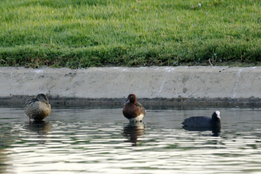 Ferruginous Duck & friends Ferruginous Duck & friends We headed north of Cadiz through some busy morning traffic. The highlights of the journey were a flock of Spoonbills coming into land in the Bahia de Cadiz and an Iberian Green Woodpecker that flew across the road in front of us, which was fantastic. Our first port of call was what appeared to be a holiday development named Costa Ballena (whale coast). Here, there was an artificial lake, just along from a water park, which was quiet enough to hold a good selection of birds. There were plenty of Coots and Mallards, and amongst them a few Shovelers and a couple of Pochard, while there also several Little Grebes. A few Little Egrets including one taking off and calling vociferously. Then, I spotted a male Ferruginous Duck. Not a bird I expected to see. I showed it to Manuel and he was pleased. “That is a good start,” he said, “I only see a few of those each year!”. 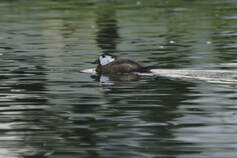 White-headed Duck White-headed Duck The main reason we were here though, was to see two male White-headed Ducks which are apparently more or less resident at the moment. This was the bird that I had decided was the best bet for a ‘lifer’ (a new bird for my life list) in southern Spain, especially when I decided to go with Manuel, who’s company is named Oxyura Birding (Oxyura is the genus of the White-headed Duck). Other birds here included a Monk Parakeet and two Rose-ringed Parakeets, two alien birds which are firmly established in Europe these days. (This is a surprisingly good site for waterbirds and unusual gulls see https://birdingcadizprovince.weebly.com/cadiz-birding-blog/update-1-march-2022-costa-ballena - JC). 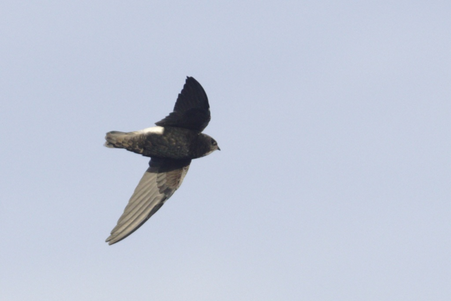 Little Swift Little Swift Our next stop was Chipiona, the home of the only Little Swift colony in Europe, although they breed just across the Straits of Gibraltar in Morocco. (Little Swifts are found breeding elsewhere in Spain - although mostly in Cadiz province - but this is by far the largest colony - JC). We need to get there before the birds left the colony for the day to feed. I was expecting to see the odd birds flying around, an expectation reinforced when Manuel saw a bird flying along the street and got quite excited. I wondered why we didn’t stop but instead we drove to the port authority building. What I wasn’t expecting was that the Little Swift colony is amongst girders in a roof in the port authority building, that you can drive right up to it and, today at least, there were about 60 Little Swifts flying around chirruping softly, right above our heads, with many of them visiting their nests on ledges amongst the girders. A few Crag Martins were also amongst the swifts and they appeared to be nesting here as well. Next, we headed north through Sanlúcar de Barrameda, which was Manuel’s home town but also an important site in world history. It was from here that Christopher Columbus departed when he discovered the New World (leaving aside the fact that it was already inhabited and that the Vikings had already been there). Ferdinand Magellan also left from Sanlúcar de Barrameda. 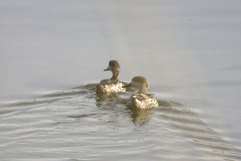 Marbled Duck Marbled Duck Manuel apologised before we reached the next birding site. “I am sorry,” he said “I try to tidy it up, but the next time I come …”. The site was what British birders seem to call Bonanza pools (I think it was me who coined the name as I believe I was one of the first British birder to find the site - JC) although the eBird name is Lagoa de Camino Colorado. These pools are in the district of Bonanza, which probably translates from the Spanish into something awfully mundane, but has all the cowboy/good fortune overtones for Anglophones. (Bonanza, comes from Medieval Latin bonacia meaning 'calm sea' - JC) The two pools can viewed from the surrounding roads (only one of which is named Camino Colorado), and they were a bit messy, with plastic and bottles strewn around. We’ve seen worse, and in general the birds don’t seem to care. The first pool was a site for Marbled Teal, and two birds swam out from the reeds beside the road and then settled on the mud on the further side of the pool. Both bore green colour-rings and although I didn’t get the numbers, another Spanish birder used Manuel’s scope to get the details. They were joined by a couple of Western Swamphens (formerly known as Purple Gallinules) while some other birds here included Black-winged Stilt, Common Snipe, Zitting Cisticola and Melodious Warbler. 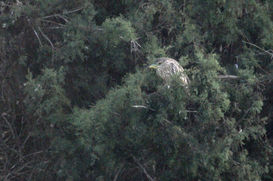 Night Heron Night Heron The next pool was viewable from the other side (in Camino Troncosa). There was a roost of Night Herons in the trees here and a Spoonbill feeding at the back. In amongst the ducks were two Pintails and a Red-crested Pochard, along with Mallards, Shovelers and Pochards, and a single Teal just as were leaving. A juvenile Greater Flamingo was swimming in the pool and looking awkward. Manuel was checking all the Coots and eventually found what he said was the only Red-knobbed Coot in the area. It was into the sun, so it was quite tricky seeing the red knobs on the head, but they could be seen as it moved its head. Other birds here included the only Tree Sparrow of the day, some Crested Larks and a Kingfisher, but we missed the Wryneck that perched up in front of Manuel and then disappeared. (For more details of this excellent site see - https://birdingcadizprovince.weebly.com/cadiz-birding-blog/march-2022-update-ii-bonanza-area) Then we headed to the Laguna de Tarelo which, despite being east of the Guadalquivir river, is part of Doñana National Park. I referred to it by its old name of Coto Doñana, but Manuel pointed out that Coto refers to a hunting preserve and, although is still allowed in parts of NP at times, the name isn’t appropriate. The laguna is artificial, and looks very square on a map, although you probably wouldn’t know from on the ground. There were another nine White-headed Ducks along with a selection of commoner waders and wildfowl we had already seen elsewhere, including Greater Flamingo and Black-winged Stilt. Four Glossy Ibises flew up the river. Some small birds were in front of the viewing blind: two Cetti’s Warblers were seen chasing each and there was also a Reed Warbler and several Sardinian Warblers. 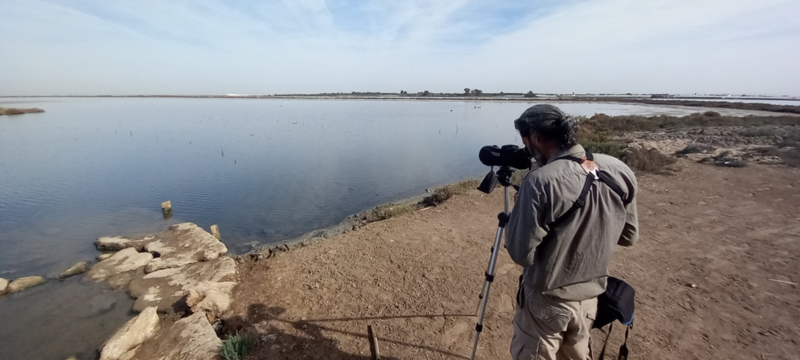 Manuel Bárcena birding at Bonanza Saltpans Manuel Bárcena birding at Bonanza Saltpans Our final birding visit of the day was to the salt pans at the Salinas de Bonanza. The research I had done before I got here suggested that the access here was restricted for birders, so here is where Manuel really came up trumps again. We drove past the innermost salt pans, which were largely birdless. “It is dead here”, Manuel commented. Too much salt. Eventually we came to a right turn with a locked metal gate blocking access, but Manuel got out and unlocked the gate and we carried on to the end of the track, which overlooked the main birding saltpans. There were plenty of new birds here: a large flock of 180 Avocets, 60 Slender-billed Gulls, Dunlin, Ringed Plovers, Redshanks, four Kentish Plovers, nine Grey Plovers and three Little Stints. Singles of Black Stork and Great Egret were part of very small wintering populations here. Raptors included three Ospreys, a female Marsh Harrier and, then, a male Hen Harrier which put almost everything to flight as it flew over the pans.almost everything to flight as it flew over the pans. A distant but still distinctive Booted Eagle was seen through the scope flying over pines to the north of the salinas. There were only a few passerines but Crested Lark, Sardinian Warbler and Stonechat were all common. Other birds included a Kingfisher and at least 30 Grey Herons. On the way back we saw a Wheatear and 25 Sanderlings amongst the ‘dead’ pans. We drove back to Cadiz along the new road, which was uneven in some places. We passed through mainly brown fields. Some were brown because they had cotton plants growing on them, and the leaves die before it is harvested. Others were brown because they had been cropped, and were bare earth. Nevertheless, the overall impression was of a dry landscape. This should be the rainy season in Andalusia but, as Manuel lamented, the autumn rains are becoming increasingly erratic. At least the fields here aren’t covered in agricultural plastic, as is the case in other parts of southern Spain. Note a slightly fuller version of this account with more photos can be found on Mike's excellent blog at whenigrowupiwillgothere.wordpress.com/2022/10/28/birding-bonanza-and-other-nearby-locations-cadiz-andalucia-spain-friday-28th-october-2022/
Thanks again to Mike for allowing me to post his account. |
About me ...Hi I'm John Cantelo. I've been birding seriously since the 1960s when I met up with some like minded folks (all of us are still birding!) at Taunton's School in Southampton. I have lived in Kent , where I taught History and Sociology, since the late 1970s. In that time I've served on the committees of both my local RSPB group and the county ornithological society (KOS). I have also worked as a part-time field teacher for the RSPB at Dungeness. Having retired I now spend as much time as possible in Alcala de los Gazules in SW Spain. When I'm not birding I edit books for the Crossbill Guides series. CategoriesArchives
May 2023
|
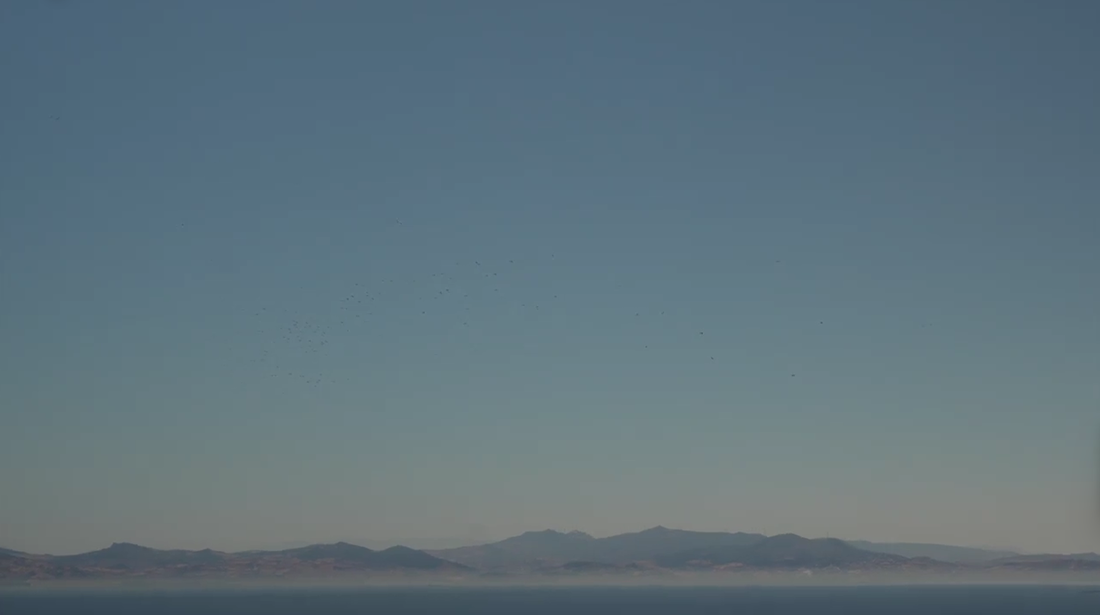
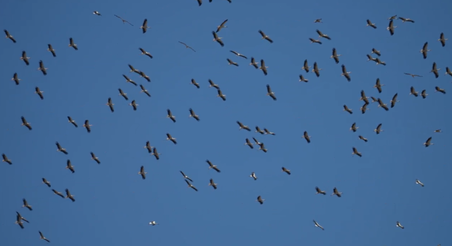
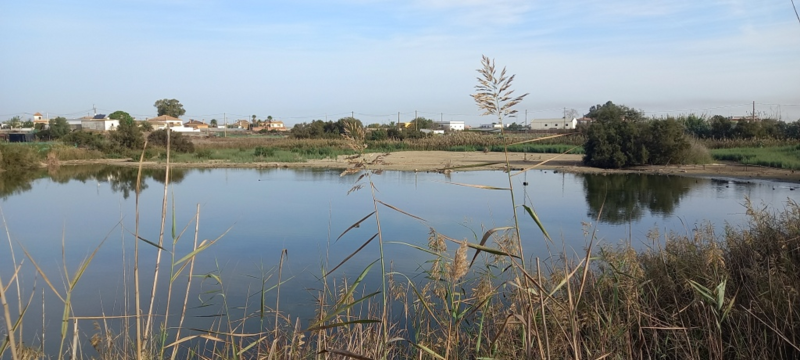
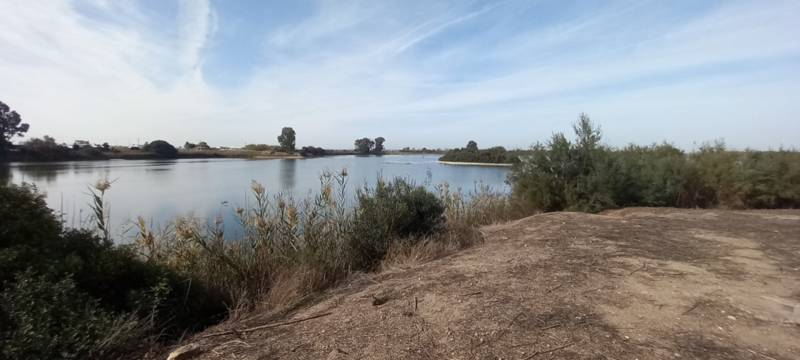
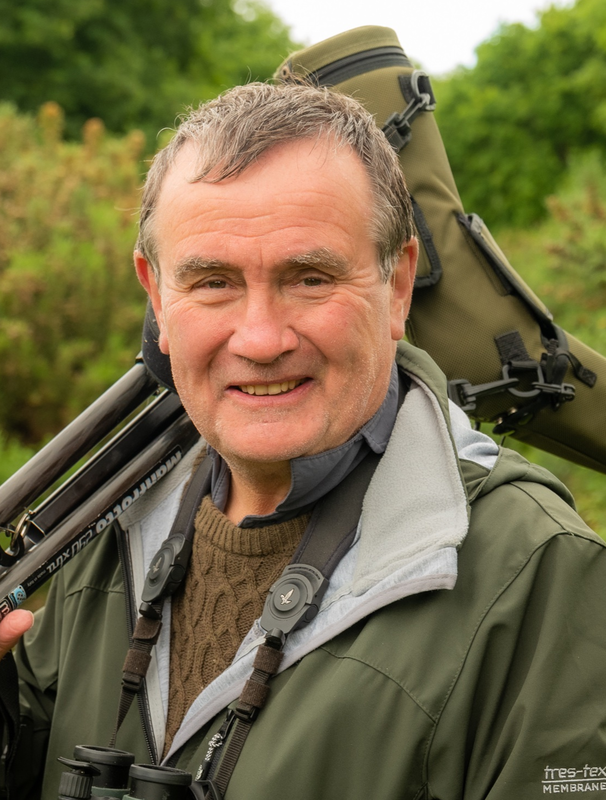
 RSS Feed
RSS Feed
